I’ve been expecting you Mr Bond
This year saw more work probing the nature of bonding. In Germany, Holger Braunschweig of Julius-Maximillians University in Würzberg, found that reacting a bis(N-heterocyclic carbene)-stabilised tetrabromodiborane with sodium naphthalene gave diborene or diboryne compounds with the world’s first stable boron–boron triple bond.1 Although boron has been an obvious target for triple bond creation, up until now the element has been reluctant and had only formed a triple bond at a chilly 8K. The new work, at room temperature, is distinctly warmer.
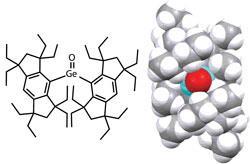
And if that main group chemistry wasn’t enough, the first compound with a germanium–oxygen double bond, a germanone, was created by Japanese scientists from the Riken Advanced Science Institute in Saitama.2 The carbon-oxygen double bond of ketones is a versatile stalwart of organic chemistry. But the heavier elements of group 14 – silicon, germanium, tin and lead – prefer to form single bonds to oxygen. The large polarisation of this bond makes these other double bonds highly reactive and prone to polymerisation. To prevent this, bulky ligands are needed to sterically protect the germanone.
Up the periodic table to hydrogen, the January issue of the magazine reported scientists’ claims that they had finally made metallic hydrogen, although others were sceptical.3 For over a century, scientists have said it should be possible to turn hydrogen into a metal, and Mikhail Eremets and Ivan Troyan of the Max-Planck Institute for Chemistry in Mainz, Germany, believe they are the first to offer conclusive evidence for this. By condensing hydrogen in the hole of an alumina–epoxy gasket, which sat inside a diamond anvil cell, Eremets and Troyan could measure light transmission with a laser and resistance via electrodes on the diamond surfaces.
However, while the pair claims their observations of electrical resistance being relatively temperature independent is enough to claim metallicity, others suspect that what was measured could not conclusively be attributed to metallic hydrogen.
Artemisinin with the flow
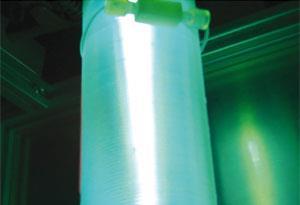
Artemisinin is the most effective therapy in the fight against the plasmodium parasite that causes malaria. Currently, the drug is extracted from sweet wormwood plants, meaning that supplies are limited, while synthesising the drug from scratch is impractical because of the compound’s fused ring structure with an endoperoxide group. Consequently, Seeberger and Lévesque instead began their synthesis from artemisinic acid, a by-product generated by current artemisinin production in quantities up to 10 times the mass of the drug.
The two chemists began by reducing artemisinic acid to dihydroartemisinic acid and then reacted the product with singlet oxygen to form a hydroperoxide. The highly reactive singlet oxygen molecule is produced by a photochemical reaction, which can be troublesome for large-scale manufacturing processes. However, by pumping reagents continuously through tubes wrapped around a lamp, Seeberger and Lévesque illuminate the entire solution efficiently.
Controversies resolved?
Post publication peer review was in the spotlight this year. First up, a long-running saga in the rarefied world of metal–oxo chemistry finally seemed to draw to a close following the voluntary retraction of three controversial papers – that some critics insist should never have been published in the first place – followed by the publication of a new paper to set the record straight.5 The work in question was performed by a group led by Craig Hill, at Emory University in Atlanta, US, who supposedly prepared and characterised a compound containing a single oxygen atom bonded to platinum. While such terminal oxo bonds are commonplace for transition metals occupying the early and middle groups in the periodic table, groups three to eight, there has been a long-standing consensus that such bonds are not possible – except in a small minority of well-defined cases – for transition metals in the higher groups, beyond group nine.
It is accepted that there is an ‘oxo wall’ at some point between groups eight and nine beyond which such atomic collusion is impossible because of excessive electronic repulsion. Hill had seemingly smashed this wall and unsurprisingly the work caused immediate controversy. Indeed, Hill himself admitted to Chemistry World that he too had remained sceptical.
Finally, in 2012, in the light of new experiments, Hill accepted that the interpretation of the data was incorrect – the oxo wall stands. This led to retraction of three papers by Hill. ‘100% of the original data in all three papers are correct but the interpretation was wrong,’ Hill said.
But from a frank admission of a scientific error, to the continuing arsenic life saga. This year, several papers emerged that all cast further doubt on Felisa Wolfe-Simon’s work at the Nasa Astrobiology Institute in the US.
Wolfe-Simon caused a media storm last year when she suggested that GFAJ-1 bacteria from Mono Lake in California were using arsenic in their DNA backbone rather than phosphorus, but the chemical literature has been quick to counter the claims. Jiande Gu, Jerzy Leszczynski and colleagues from Jackson State University, US, and the Chinese Academy of Sciences ran a computational study to probe the stability of DNA with an arsenate back bone.6 However, while they found that DNA’s base-stacking could increase the resistance of arsenate towards hydrolysis, it would still be less stable when compared with traditional DNA with a phosphate backbone.
Rosie Redfield of the University of British Columbia, Canada, chronicled her attempts to replicate Wolfe-Simon’s work on her blog in an example of open notebook science, before subsequently publishing her findings that suggest Wolfe-Simon’s original data was due to contamination.7 Later on Dan Tawfik, at the Weizmann Institute of Science, Israel, and colleagues decided to investigate how exactly GFAJ-1, and other bacteria that live in arsenic rich environments, survive. The trick, suggested Tawfik, is in the peristaltic phosphate binding proteins which are highly tuned in GFAJ-1.8 Although arsenate ions are only a little larger than phosphate, that size difference is enough to distort a low energy hydrogen bond and stop arsenate uptake.
Printing labware to order
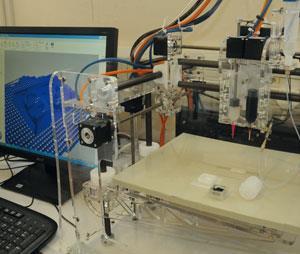
Using a self-built 3D printer, Cronin made a reaction vessel using a quick drying silicone polymer, usually used as bathroom sealant, as the ‘ink’.9 The resulting plastic vessel comprised two separate solution-holding chambers both leading to a larger mixing and reaction chamber. Cronin and his team tried this process mixing both organic and inorganic chemicals in the reaction chamber and found that they were able to produce an organic heterocycle and two inorganic nanoclusters that had never been seen before. By inserting electrodes into the reaction vessel, they were also able to perform electrochemical reactions and even turn the vessel into a working electrochemical cell. But that was just the tip of the iceberg. Cronin showed that he could alter the progress of a reaction by simply changing the architecture of the reaction vessel, for example using different chamber sizes, and then showed that the reaction vessels could play an active role in a chemical reaction. This was achieved by adding catalytic particles of palladium to the polymer ‘ink’.
Later in the year, Cronin’s group then updated us with the news that they’d also printed intricate milli- and microfluidic devices.10 Ultimately, this technology offers scientists the freedom to design bespoke reactors using low cost materials, with a quick production turn-around of less than a day. We await with interest to see how this is taken up and used by the community.
Life’s code in chemistry
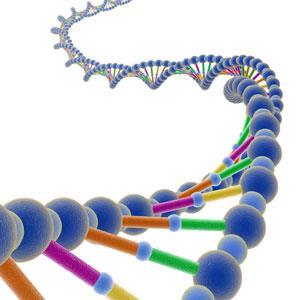
We should all be aware these days of the RNA world hypothesis, that before DNA, RNA was early life’s genetic material but what came before RNA? John Chaput and colleagues at Arizona State University in Tempe homed in on TNA, threose nucleic acid.11 To potentially be the precursor to RNA, TNA would need the ability to undergo tertiary folding into novel functional structures that bind ligands and catalyse reactions. To show this Chaput’s group used in vitro selection to evolve a population of TNA receptors that could bind to an arbitrary target and then developed polymerase enzymes to transcribe strands of DNA into their TNA counterparts. The TNA polymers were then shown to fold and bind ligands just like RNA and DNA do.
But threose isn’t the only substitution that’s been made into nucleic acids. Phil Holliger of the MRC Laboratory of Molecular Biology in Cambridge, UK, made six polymer alternatives that can pass on genetic?information.12 These xeno-nucleic acid (XNA) polymers each replace DNA’s ribofuranose sugar ring with cyclic structures that can still form helical chains and base pairings. The scientists exploited polymerase and reverse transcriptase enzymes to copy genetic information from DNA templates to XNAs. As well as further probing the basis of chemical evolution, the group also repeated replication cycles to evolve potent aptamers, molecules that could act as drugs by recognising and binding to specific targets.
A silky finish
From one polymer to another, our pages were filled with applications for, and inspiration from, silk this year. First up, Guoqiang Li’s group from Louisiana State University in the US used fibres inspired by spider silk to make a new self-healing material.13
Li’s team spun polyurethane shape memory polymers into threads. They then made a composite material containing these threads. When heated the fibres in the composite contract, pulling the edges of any cracks together, sealing them. The threads in the composite were able to repair cracks 3mm wide and restore the material to 94% of its original strength.
Self-healing materials are an incredibly active area of research and if you’d like to remind yourself about the field you can go back to our November issue and our feature article – Polymer heal thyself.
The cyborg jellyfish

Inspired by a juvenile stage of the jellyfish Aurelia aurita, Kit Parker’s team at Harvard University made the cyborg jellyfish from a flat disc of silicone polymer with eight surrounding wedge-shaped lobes.14 Onto one side of the disc and lobes Parker coated heart muscle cells from a rat. When placed in salt water and exposed to a fluctuating electrical field, the heart muscle cells contract, forcing the lobes downwards and driving the jellyfish forwards. As the heart cells relax, the lobes naturally recoil back to their original position, ready for another contraction. The resultant jellyfish were able to swim just as fast as juvenile A. aurita and could also replicate their feeding mechanism.
But this isn’t just a curiosity, the pumping action of the jellyfish means they could also form the basis for a new breed of artificial heart, and Parker and the team are looking at the possibility of using the jellyfish to test novel heart drugs.

Later in the year, Kaplan also showed that delicate vaccines and antibiotics could be stored in freeze-dried silk, eliminating the need for refrigeration.16 Perhaps one day drugs and vaccines will be trapped in silken packages, easily stored and transported and then delivered by sticking patches on an arm, just like a plaster.
Singaporean and Australian researchers showed that golden orb spider silk contains its own insect repellent.17 Mark Elgar, at the University of Melbourne, Australia, who led the study in collaboration with colleagues at the National University of Singapore, was curious why ants, formidable predators, were not often seen on the webs of spiders. Using gas chromatography–mass spectrometry the team showed that the webs of adult and large juvenile spiders contained 2-pyrrolidinone, which deterred three species of ant. Elgar suggests the discovery, as well as helping in the study of spiders, could lead to new ant deterrents. Perhaps my picnics will be safe in the future!
Bright idea to probe bond order
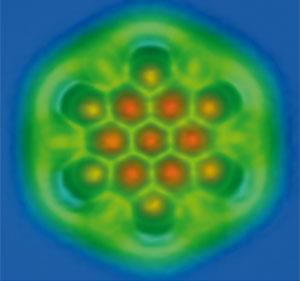
Gross and colleagues found that the bond order in planar molecules correlates with the brightness of the bonds in the image, which is a measure of the force between the bond and the AFM probe tip. And, as might be expected, the apparent bond length in the images is related to the bond order: higher-order bonds are shorter. This works not just for integer bond orders but also for different resonant structures.
Gross thinks that the approach might ultimately yield information about local atomic structures that could not be easily obtained by other methods, such as diffraction. For example, investigating defects within a graphene lattice, just as with the nanographene molecule pictured.
Tasty chemistry
Our pages also featured many stories about an aspect of chemistry that we all care about – food and cooking. It began in January with the news that caffeine levels in shop bought coffee could be well above the recommended daily allowance set by the UK Food Standards Agency (FSA).19 Alan Crozier and colleagues at the University of Glasgow, UK, analysed espressos purchased ‘to go’ from local coffee shops using high performance liquid chromatography and found large variations in caffeine levels (51–322mg). According to the FSA, pregnant women should restrict caffeine content to below 200mg per day.

But it’s not just caffeine that’s a problem, acrylamide in coffee, and other foods, is also too high.
Ten years after a Swedish study found worryingly high levels of acrylamide in baked and fried foods, a report from the European Food Safety Authority found that little has changed and levels are still too high.
Acrylamide is a known neurotoxin and carcinogen in rats. While the majority of studies have failed to find a link between acrylamide consumption and most human cancers, high dietary levels of the chemical have been shown to increase the risk of developing uterine and ovarian cancer.
Chemists even managed to solve the ‘mystery of green bacon’ this year.20
The green pigmentation, known as nitrite burn, on bacon is the result of a reaction between the nitrite preservative and myoglobin. And George Richter-Addo and his group at the University of Oklahoma, US, have fully characterised the structure of nitrite burn using single crystal x-ray diffraction. Most significantly, they found that nitration occurs at the 2-vinyl group of the haem macrocycle, but not the 4-vinyl, which is attributed to steric factors. This is a first step towards understanding the burn and what implications for health it might pose.
But from things you might not want too much of in your food, to the introduction of ‘good bacteria’ that you do.
We all now know about probiotic bacteria and most of our yoghurts now shout about the health benefits of them. However, while the bacteria can live happily in the yoghurt, they don’t fare so well in our stomachs and often don’t survive to reach the intestines where they’re needed.
Materials scientist Vitaliy Khutoryanskiy, microbiologist Dimitris Charalampopoulos and their colleagues at the University of Reading, UK, overcame the problem of the bacteria dying before they could enter the intestines by building them a coat of alginate and chitosan layer-by-layer.21 This coat protects the bacteria as it travels through the stomach to the intestines, before being released as the pH changes.
With that we draw our roundup to a close. As always this has been only a small snapshot of the last year’s research and I hope that this has whetted your appetite for the year to come.
References
1 H Braunschweig et al, Science, 2012, 336, 1420 (DOI: 10.1126/science.1221138)
2 L Li et al, Nat. Chem., 2012, DOI:10.1038/nchem.1305
3 M I Eremets and I A Troyan, Nat. Mater., 2011, DOI: 10.1038/nmat3175
4 F Lévesque and P H Seeberger, Angew. Chem., Int. Ed., 2012, DOI: 10.1002/anie.201107446
5 K P O’Halloran et al, Inorg. Chem., 2012, DOI: 10.1021/ic2008914
6 J Wang, J Gu and J Leszczynski, Chem. Commun., 2012, DOI:10.1039/c2cc16600c
7 M L Reaves et al, Science, 2012, 337, 470 (DOI: 10.1126/science.1219861)
8 M Elias et al, Nature, 2012, DOI:10.1038/nature11517
9 M D Symes et al, Nat. Chem., 2012, DOI: 10.1038/nchem.1313
10 P J Kitson et al, Lab Chip., 2012, DOI: 10.1039/c2lc40761b
11 H Yu, S Zhang and J C Chaput, Nat. Chem., 2012, 4, 183 (DOI: 10.1038/nchem.1241)
12 Z Yang et al, J. Am. Chem. Soc., 2011, 133, 15105 (DOI: 10.1021/ja204910n)
13 G Li, H Meng and J Hu, J. R. Soc. Interface, 2012, DOI: 10.1098/rsif.2012.0409
14 J C Nawroth et al, Nat. Biotechnol., 2012, DOI: 10.1038/nbt.2269
15 K Tsioris et al, Adv. Funct. Mater., 2011, DOI: 10.1002/adfm.201102012
16 J Zhang et al, Proc. Natl. Acad. Sci. USA, 2012, DOI: 10.1073/pnas.1206210109
17 S Zhang et al, Proc. R. Soc. B, 2011, DOI: 10.1098/rspb.2011.2193
18 L Gross et al, Science, 2012, 337, 1326 (DOI: 10.1126/science.1225621)
19 T W M Crozier et al, Food Funct., 2012, DOI: 10.1039/c1fo10240k
20 J Yi and G B Richter-Addo, Chem. Commun., 2012, DOI: 10.1039/c2cc31065a
21 M T Cook et al, J. Mater. Chem., B, 2013, DOI: 10.1039/c2tb00126h
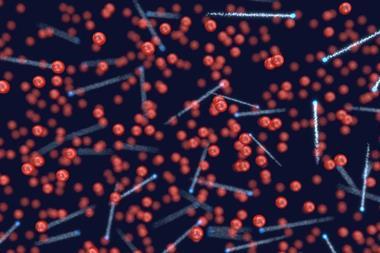











No comments yet